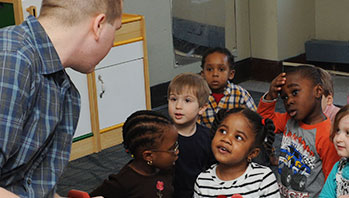- carnation experiment from yesterday
- photo of carnation
- “Plants All Around” chart
- leaves
- plant
- root
- stem
MA Standards:
English Language Arts/Speaking and Listening/SL.PK.MA.1: Participate in collaborative conversations with diverse partners during daily routines and play.
English Language Arts/Language/L.PK.MA.1: Demonstrate use of oral language in informal everyday activities.
English Language Arts/Language/L.PK.MA.6: Use words and phrases acquired through conversations, listening to books read aloud, activities, and play.
MA Draft STE Standards
Life Sciences/Ecosystems; Biological Evolution/LS2/4.B: Using their experiences in the local environment and other evidence, raise and discuss questions about the basic needs of familiar organisms and how they might meet their needs. (Clarification statement: basic needs include water, food, air, shelter, and light for most plants)
Life Sciences/From Molecules to Organisms: Inheritance and Variation of Traits/LS1/3.A: Describe/draw and compare the body parts of animals (including themselves) and plants they are investigating [System] and explain functions of some of the observable body parts. [Structure and Function]
Head Start Outcomes:
Science Knowledge/Conceptual Knowledge of Natural and Physical Worlds: Observes, describes, and discusses living things and natural processes.
Language Development/Receptive Language: Attends to language during conversations, songs, stories, or other learning experiences.
Language Development/Expressive Language: Uses language to express ideas and needs.
PreK Learning Guidelines:
English Language Arts/Language 1: Observe and use appropriate ways of interacting in a group (taking turns in talking; listening to peers; waiting until someone is finished; asking questions and waiting for an answer; gaining the floor in appropriate ways).
Science and Technology/Life Sciences 10: Observe and identify the characteristics and needs of living things: humans, animals, and plants.
Talk Together: Roots and Stems

© Commonwealth of Massachusetts, Department of Early Education and Care (Jennifer Waddell photographer). All rights reserved.
STEM Key Concepts: Plants need water, food, and sunlight to grow; Plants have different parts: roots, stems, leaves, and fruit
ELA Focus Skills: Listening and Speaking, Vocabulary
Review with children the parts of a plant. Remind children of the carnation stem you placed in colored water yesterday. Hold up the picture you took of the carnation and ask children to help you name the parts of the plant. Point to each part as children name them. (stem, leaf, flower)
Now show children the carnation and discuss the changes it went through. Help children determine how the plant gets water and nutrients from the roots and travels up the stem by asking questions such as,
- Where do you think the red water from the glass went?
- Why do you think the flower is red?
- How do you know the water traveled up through the plant?
Reinforce that the roots get water from the dirt and the water travels up through the stem to the leaves and flower. Encourage children to describe the changes as you record them on the “Plants All Around” chart. Then have children draw a picture of the change in their notebook. Help children record a caption for their drawing.
Take It Further: You may want to extend the concept by having children carry out the exploration in a new way.
- Trim a stem at the bottom. Then make a slit up the middle of the stalk stopping an inch below the leaves.
- Fill two glasses half-full with water. Mix a few drops of food coloring into the water in each glass (use different colors in each glass).
- Place the glasses next to each other. Put one-half of the stem in one glass and the other half in the other glass. Leave overnight.
- The next morning, have children observe the changes. (Each half of the stem will have absorbed the colored water and the two colors will have blended as they moved up inside the stem.)
